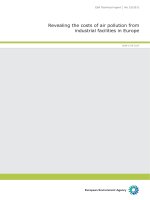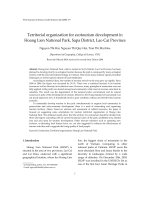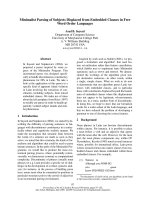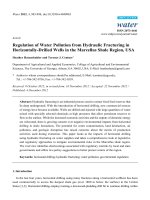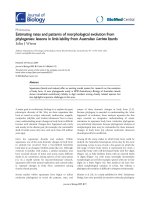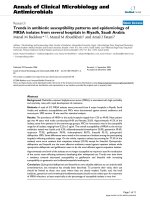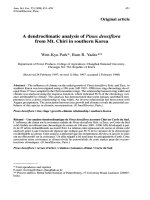Research issue of sharing benefits from ecotourism activitives in tam dao national park
Bạn đang xem bản rút gọn của tài liệu. Xem và tải ngay bản đầy đủ của tài liệu tại đây (533.93 KB, 44 trang )
MINISTRY OF AGRICULTURE AND RURAL DEVELOPMENT
VIETNAM NATIONAL UNIVERSITY OF FORESTRY
STUDENT THESIS
RESEARCH ISSUE OF SHARING BENEFITS FROM ECOTOURISM
ACTIVITIVES IN TAM DAO NATIONAL PARK
Major:
Natural Resources Management
Faculty: Forest Resources and Environmental Management
Student: Nguyen Ba Ninh
ID: 1354032644
Class: K58A Natural Resources Management
Course: 2013 - 2017
Advanced Education Program
Developed in collaboration with Colorado State University, USA
Supervisor: Dr. Ngo Duy Bach
HaNoi, 09/2018
TABLE OF CONTENTS
TABLE OF CONTENTS............................................................................................................... i
LIST OF TABLES ....................................................................................................................... iii
LIST OF FIGURES ..................................................................................................................... iv
ACKNOWLEDGEMENTS .......................................................................................................... v
ABSTRACT.................................................................................................................................. 1
CHAPTER I : LITERATURE REVIEW ...................................................................................... 2
1.1.
The concept of ecotourism ................................................................................................. 2
1.2.
Features and some basic principles of eco-tourism ........................................................... 3
1.2.1.
Features of eco-tourism .................................................................................................. 3
1.2.2.
Some basic principles of eco-tourism ............................................................................ 3
1.3.
The relationship between ecotourism and national park ................................................... 4
1.3.1.
Major relationships......................................................................................................... 4
1.3.2.
The benefits of eco-tourism can be attributed to the national park ................................ 5
1.3.3.
Negative impacts may arise from eco-tourism to national parks ................................... 6
1.4.
The relationship between ecotourism and local communities ........................................... 6
1.4.1.
Positive influences ......................................................................................................... 6
1.4.2.
Negative influences ........................................................................................................ 7
1.5.
The status of ecotourism in Vietnam ................................................................................. 8
CHAPTER II: INTRODUCES ..................................................................................................... 9
2.1.Biological resources ................................................................................................................ 9
2.2.Other conditions .................................................................................................................... 11
CHAPTER III: METHODS AND PROCESS OF RESEARCH ................................................ 12
3.1. Methods ............................................................................................................................... 12
3.1.1. Survey method .................................................................................................................. 12
3.1.2.Participatory Rapid Appraisal (PRA) ................................................................................ 13
i
3.2. Process of research............................................................................................................... 14
3.2.1. The process of collecting secondary materials ................................................................. 14
3.2.2.Process of research............................................................................................................. 15
CHAPTER IV : RESEARCH RESULTS ................................................................................... 18
4.1. Overview of respondents ..................................................................................................... 18
4.2.Status of ecotourism activities in Tam Dao National Park ................................................... 19
4.2.1.The development of ecotourism in Tam Dao National Park ............................................. 19
4.2.2.The benefits of eco-tourism to local communities............................................................. 20
4.2.3.The attitude of the national park and the local community on the benefits sharing
from ecotourism .......................................................................................................................... 25
4.2.4.Factors limiting benefit sharing in national parks and local communities ........................ 31
4.2.5.A solution for the issue of sharing ecotourism benefits between national parks and
local communities ....................................................................................................................... 32
CHAPTER V: CONCLUSIONS ................................................................................................ 34
CHAPTER VI : DISCUSSION .................................................................................................. 36
CHAPTER VII : REFERENCES ............................................................................................... 38
ii
LIST OF TABLES
Table 1: Biogas targets for humans. ........................................................................................... 9
Table 02: Tam Dao fauna composition..................................................................................... 10
Table 03: Age profile of respondents. ...................................................................................... 18
Table 4. Eco-tourism revenue of Tam Dao National Park (2008-2010) .................................. 21
Table 5: Possible benefits through services - goods for tourism. ............................................. 23
Table 6: Survey results of community attitudes and attitudes towards tourism impact on
the region .................................................................................................................................. 28
iii
LIST OF FIGURES
Firgue 1 : Population distribution by age group .................................................................... 19
Figure 2: Income structure of Tam Dao National Park in 2010 ............................................ 21
Figure 3: Benefits of tourism activities in Tam Dao National Park to local communities .... 24
iv
ACKNOWLEDGEMENTS
The consent of Vietnam National University of Forestry, Faculty of Management of
Forest Resources and Environment, Department of Environmental Management, I made
thesis “Research issue of sharing benefits from ecotourism activities in Tam Dao National
Park”. In time to implement the project with the efforts of myself I have received a lot of
help, instructions of the teachers, organizations and individuals in and outside the school.
I would like to sincerely thank the teacher, Dr.Ngo Duy Bach. He has guided and
helped me a lot in the process of implementing research topics.
I would like to express thanks to Tam Dao National Park management, organizations
and people of Tam Dao Town, Vinh Phuc province helped me during practice.
Despite a lot of effort but due to lack of practical experience and professional
qualifications are limited . I am looking forward to receiving the comments of teachers.
Sincere thanks !
Hanoi, September 4th, 2018
Students
v
ABSTRACT
National parks (NPs) and attractive natural landscapes are attracting domestic and
foreign tourists. It makes investors interested in using and investing in ecotourism
development by the abundance of nature and the diversity of the ecosystem .They are
considered as the basis for ecotourism development but one of the important things to help
eco-tourism develop sustainably and ensure the conservation of the park's natural resources
is the human community local people.
The involvement of local communities in local development activities has been
increasingly mentioned and considered to be an inevitable factor in the development of
ecotourism. Local communities live by exploiting and hunting from available forest
resources. Since the establishment of a national park located in or in the buffer zone, there
is limited hunting and exploitation of forest resources. In order to compensate for these
disadvantages, many policies and projects have been developed to improve the quality of
life of people.
Most national parks are developing tourism projects that bring benefit to local
communities based on conservation objectives. However, the efficiency brought about by
the projects is not large and still does not support much in the development of local
community economy. Community involvement in the development of ecotourism is a very
important factor. But the fact that the participation of people in ecotourism activities is
limited and passive, spontaneous. One of the reasons is the issue of sharing the benefits of
national parks and tourism companies with the communities living in the buffer zone. Most
of the profits are in the hands of individuals or travel companies, national parks have
economic and level resources.
Tam Dao National Park is one of the national parks with great potential for ecotourism development. Tam Dao National Park attracts thousands of visitors. However, the
issue of sharing benefits with the community is still inadequate. People remain on the
sidelines of eco-tourism activities in the national park. In addition, the national park is
considered to be a source of income from tourism for business organizations and
individuals who are marginalized within the protected area of the national park.
1
CHAPTER I : LITERATURE REVIEW
1.1. The concept of ecotourism
Until the 1980s, this new type of tourism began to be considered. In 1991, the
concept of ecotourism emerged as a type of alternative tourism with great appeal.
Ecotourism is defined at its earliest stages as follows:
"Ecotourism is a type of tourism that takes place in areas with well-preserved natural
ecosystems aimed at studying, admiring, enjoying landscapes, animals and plants as well
as cultural values. existing "(Boo, 1991).
Then there are a lot of different definitions of ecotourism that many researchers have
come up with. Although there are many expressions, they are generally focused on
emphasizing the nature of tourism.
In a definition given at a conference in Canada, “Ecotourism is a natural form of
tourism that contributes to preserving the ecosystem while respecting the integration of
local communities.” Sustainable management factors include content that supports local
socio-economic development.
Thus, the definition of ecotourism through a variety of definitions has emphasized
that ecotourism is not simply a travel to a natural area enjoying a little passive and less It
also has to be environmentally responsible, highly educated, contributing to the
conservation and development of natural resources, benefiting the local community in
terms of both the environment and the environment. economic, cultural and social.
At the Ecotourism Conference in Vietnam, the concept of ecotourism is as follows:
“Ecotourism is a form of nature tourism with high levels of ecological and
environmental education that positively impacts on environmental and cultural protection,
ensuring financial benefits to the community. and contribute to conservation efforts”
2
This definition fully covers the content and nature of ecotourism in a fundamental
way with the concepts of the researchers. Thereby, we find that ecotourism is considered as
a type of tourism in which it includes the positive aspects of some types of tourism.
1.2. Features and some basic principles of eco-tourism
1.2.1. Features of eco-tourism
The characteristics of ecotourism are different from other types of tourism as follows:
Based on cultural factors - indigenous history and the attractiveness of the natural
landscape
Support for conservation and ecological sustainability.
Linking with environmental education in ecotourism is effective in changing the
attitudes and behaviors of tourists, the community and the tourism industry in terms of
conservation and resource development. contributing to the sustainability of ecotourism.
Support local economy, encourage the participation of local communities: Local
people, environment, culture, lifestyle and traditions of local people play an important role
in tourism. It is an important factor to attract tourists to a tourist destination. Local people
should be able to meet their needs and aspirations.Eco-tourism can help to develop
benefits, stimulate economic development and provide opportunities for diversification of
the economy. Ecotourism can become a tool to support conservation and development, but
this will only become a reality. "If there is a concerted effort to link the local community to
ecotourism "This is also a way for people to become active members in conservation.
1.2.2. Some basic principles of eco-tourism
Ecotourism develops on the principles of sustainable development. The principles
ensured in ecotourism are not only for the planners, managers, organizers and operators of
tourism, but also for guides, both local communities.
Serving the needs of rest, participate in leisure, explore, learn the nature of people.
3
Support the conservation of ecotourism resources in particular and natural
resources in national parks and nature reserves in general.
Support the local economy, creating more long-term economic benefits for the
local community , who have ownership in development and in tourism planning. This is the
goal of sustainable tourism.
1.3. The relationship between ecotourism and national park
The need to learn from nature is increasing, which is the main driving force for
tourists to eco-tourism. However, there will be a great pressure on national park resources
as the number of tourists is increasing.
1.3.1. Major relationships
The development of tourism in national parks in the conservation of natural
resources has the following three main relationships:
The relationship between tourism and conservation is independent : When the new
tourism activity is started, the level of resource use is not high, the relationship is often in
the form of independent co-existence. This means that both tourism and conservation are
less related.
The relationship between tourism and conservation is supportive: As the level of
natural resource use increases, if tourism is well planned, managed, and consistent with the
principle of sustainable tourism, this relationship will be positive relationship, mutual
support together development.
Supportive relationship: With this relationship, tourism creates a prerequisite for
the conservation of natural resources, and vice versa, natural resources create the driving
force for tourism development.
Contradictory relationship: If tourism is overly developed without the concern for
conservation, then this relationship will become contradictory. Tourism, therefore, will
4
cause the destruction of natural resources. It is also recognized that this is a reality that is
happening in national parks and reserves of Vietnam resources.
Therefore, eco-tourism, when carefully planned, respects the principles of
ecotourism, will create a supportive relationship with conservation activities of the national
park.
1.3.2. The benefits of eco-tourism can be attributed to the national park
Eco-tourism can bring many benefits to the national park. Ecotourism is considered
to be a good financial aid for conservation and development of natural resources in national
parks and nature reserves. The benefits of ecotourism for national parks and nature reserves
are also of great interest. These benefits can be summarized as follows:
Motivating the conservation and development of national park resources.
When the revenues from ecotourism are sufficiently large, the accounting
mechanism, if applied properly, can create a financial self-financing mechanism that
supports the conservation and development of the national park resources. develop
ecotourism of the national park.
Creating opportunities for visitors to interact with the sights of the mystery of
nature, contributing to raising the awareness and awareness of conservation of the people,
actively supporting the conservation and development of natural resources. natural
resources of the national park.
Facilitate the exploration of potential lowland areas for economic development,
stimulating the development of neighboring areas.
Improve the economic and social life, improve the cultural life and spirit of the
local community.
5
1.3.3. Negative impacts may arise from eco-tourism to national parks
National parks are currently facing negative impacts due to the adverse effects of
ecotourism. Local people exploit products from the national park for tourism and increase
the amount of other tourism to the national park every year.
The overload of ecotourism due to the increasing number of tourists entering the
national park causes negative impacts on natural resources.
Impacts on national parks are divided into two categories: direct impacts and
indirect impacts. The direct impact caused by the presence of tourists, and the indirect
effects arising from the construction of infrastructure for ecotourism activities, related
tourism services to ecotourism activities.
Direct impacts on geological and mineral structure, fossils, land, water resources,
forest fauna and flora ...In addition, the demand of tourists to use the special food from
wildlife, the collection of live animals lead to some animals are hunted excessively. This is
an indirect cause, but it plays a decisive role in reducing the number and quality of animal
populations.
Impact on the natural landscape, on the cultural environment. The ecological effects
of tourism activities rarely occur singly. Places with a variety of recreational activities will
be the first to be affected, and can be used to predict changes or occur elsewhere where
there is an increase in use or misuse. In summary, these activities will increase
proportionally to tourism-related activities and inversely proportional to tourism
monitoring and management.
1.4. The relationship between ecotourism and local communities
1.4.1. Positive influences
Contributing to changing the quality of community life is the direct participation in
tourism. This includes the improvement of social services such as health, education,
electricity and water...
6
Create employment opportunities for local communities who are directly or
indirectly involved in tourism activities and the management of natural resources of the
national park.
Ecotourism is a great means of earning foreign exchange, diversifying the local
economy by the chain effect, creating direct and indirect benefits.
Ecotourism is also a driving force for improving infrastructure, transportation,
communications, and local health facilities, which are beneficial to local communities.
Ecotourism enhances mutual understanding between tourists and locals, introduces
local values and traditions, contributes to improving the people's intellectual level and
makes social relationships more and more advanced.
Ecotourism also has the potential to bring economic benefits to local people
through services that satisfy the needs of tourists.
1.4.2. Negative influences
Regardless of the type of tourism, massive development without control can have
negative economic and social impacts and the target population is often local people.
Negative economic impacts. Tourism may be a factor contributing to the economic
development can also cause economic underdevelopment. For those who have economic
potential, tourism brings many benefits to them. So, tourism can increase the gap between
the rich and the poor.
Tourism causes overloading of existing infrastructure such as the ability to provide
electricity, water, fuel, waste treatment ... Conversely, if the infrastructure is designed and
planned large more than the demand for use, the efficiency of using towers, slow return of
capital causes loss or lead to price increases unreasonably.
Negative impacts on socio-cultural performance: In tourism activities, negative
impacts on local socio-culture have become quite common in many countries. The impact
on customs, lifestyles, local cultural traditions is often not better.
7
Tourism and the negative aspects of it bring the locality together. Negative social
issues: gambling, drug addiction and prostitution are the evils that tourism can be one of
the causes of or tolerance. These phenomena can be seen in some places: Bangkok Thailand, Sa Pa - Vietnam.
In order to avoid the negative impacts of ecotourism, the planning and planning of
ecotourism development, ensuring the basic requirements and principles of ecotourism is
very necessary before Ecotourism activities are encouraged in a nature reserve.
1.5. The status of ecotourism in Vietnam
In recent years, the number of tourists visiting the tourist destinations with
outstanding potential is the natural environment, although not the nuance of ecotourism in
our country increasingly. It is estimated that over 40% of total international tourists and
60% of domestic tourists.
Among the domestic visitors to nature reserves and national parks, the majority of
them are students, researchers and the rest are small. Therefore, it can be said that
ecotourism is taking place in national parks and nature reserves are not really eco-tourism
in their own right. In addition, tourism and conservation are showing an independent, even
contradictory relationship. While the goal of eco-tourism is to support conservation and
economic development locally.
8
CHAPTER II: INTRODUCES
2.1.Biological resources
Three islands national park divided into three main zones
Strict protection zone: This is an area of natural forest and the main habitat of
animals in the forest.
Ecological Rehabilitation Zone: Located around the strict protection zone, since the
area was formerly located outside the Tam Dao forest, the forest was severely damaged,
leaving only 13,000 ha of natural and plantation forest.
Resort and tourism area: 2,302 ha, including aquatic systems of Thac Bac and Dong
Bua streams. There are both natural and plantation forests.
Class
Meaning
Average
annual
temperature
Average
temperature of the
hottest month (0C)
Average heat
amplitude of
year (0C)
Rainfall of the
year (mm)
(0C)
1
Adapt
18 - 24
24 - 27
<6
1250 - 1990
2
Adequate
24 -27
27 - 29
6-8
1990 - 2550
3
Hot
27 - 29
29 - 32
8 - 14
> 2550
4
Very hot
29 - 32
32 - 35
14 - 19
< 1250
5
Unbecoming
> 32
> 35
> 19
< 650
Table 1: Biogas targets for humans.
Due to the characteristics of the terrain, sunlight, altitude, hydrographical climate, it
has created
a diversity of Tam Dao fauna and flora. Through research, Tam Dao National Park
has 904 species of 478 genera, 213 study of higher plants. Among them, 823 species, 442
genera, 182 families were the most abundant species. 42 species are considered endemic to
Tam Dao National Park.
9
Due to the topographical, elevation, climate and hydrographical characteristics, it has
created a variety of species, distribution and values of the fauna and flora of Tam Dao.
Tropical evergreen tropical rain forest type: Usually distributed at the height of less
than 800m, but due to the effect of slope, the drying direction can be distributed at the
height of 900 - 1000m. The valuable trees are Cho Chi (Shoera chinensis), Gioi (Michelia
Ital), Re (Cinnamomum Ital) ...
Type of evergreen moist tropical rainforest: Distribution from 800m and above but
sometimes distributed over 900m. The flora of this forest type is no longer
Dipterocarpaceae. Plants include species of the Re (Lauraceae), De (Fagaceae), Che
(Theaceae)
Dwarf forest on the top of the mountain: The dwarf forest on the top of the
mountain is a typical sub-type of evergreen moist lowland moist montane evergreen forest
formed on sloping top ridges or high peaks of bony land, sunny and windy. , fog often
covered. Plants are mainly plants of the family Ericksae, Michelia faveolata, ...
Other forest types: Bamboo forest, post-shifting cultivation, plantation forest ...
Fauna: Tam Dao fauna has recorded 840 species of animals including 64 species of
mammals, 240 species of birds, 75 species of reptiles, 28 species of amphibians and 434
species of insects. Shown in Table 02
Class
Order
Family
Genus
Species
Animals
8
25
48
64
Birds
15
50
140
239
Reptile
2
14
46
75
Amphibians
3
7
11
28
Insect
8
48
271
434
38
144
516
840
Total
Table 02: Tam Dao fauna composition
10
2.2.Other conditions
In addition to the natural attractions, Tam Dao can exploit a number of points,
ecological tourism routes as follows:
Ha village to Bac falls, visit the botanical gardens, semi-wildlife, see some
waterfalls, natural forests, bird watching, butterflies, and some other insects.
Route from Tam Dao town to Tam Dao 2. Trekking in tropical rainforest, see
some endemic plant species such as Trau Tien, Tra Hoa Vang, Do Quyen ..., camping and
sightseeing of three provinces at Rung Rinh
National route to Tham Thinh - Long village, tourists can take a bath and view
the waterfall
Boat trip on Xa Huong lake and Ha village to admire natural scenery, pine forest,
Lim Xanh ...
11
CHAPTER III: METHODS AND PROCESS OF RESEARCH
3.1. Methods
3.1.1. Survey method
The survey methodology used in this study was mainly conducted through
questionnaires. With 3 types of questions yes no question , selected available questions ,
short answer . This is the most appropriate method of investigation because it is applied to
a large number of community members who focus on the same topic and are doing so in
the short term.
The questionnaire was prepared in a set sequence. The data obtained through the
questionnaire is systematic and easy to analyze. Thus, the data analysis process is faster
and less expensive. This allows the investigator to collect a wide range of data from a large
number of interviewees, so it is well suited to the study.
We have 120 samples include : Tam Dao implemented in the number of 50 samples,
tourists 60 samples, staffs and personnel Travel guide made 10 samples. We calculated
how many percent for one question to evaluate issue of sharing benefit .
Statistics count the percentage of respondents to provide results for assessing the
impact of benefit sharing. To clarify the impact of ecotourism on each factor, Likert's point
average is used. By this calculation the scale is divided by -5 to +5 with: very bad is -5,
bad is -2.5, very good +5, good is +2.5; The answer is not counted as 0 points. Unknown
answers are not scored and not recorded. Answers are scored as answers are recorded.
We have samples interview
12
13
3.1.2.Participatory Rapid Appraisal (PRA)
Participatory Rapid Appraisal is a special type of Rapid Rural Appraisal (RRA).
PRA is a set of techniques and approaches that enable communities to share, enhance and
analyze their knowledge of life and the environment while planning and acting on their
own.
In the PRA method, understanding of insiders is taken as the starting point.
Therefore, the investigator must have a clever approach so that the knowledge is presented
voluntarily without imposing.
The PRA method is most effective in evaluating rural communities. Not much
time and cost is the main strength of PRA.
Key principles: The main principle of PRA is expressed in triangular form. This is
the relationship between the review team, the news feed and the tools and techniques of the
assessment. This guiding principle creates cross-checking and coordinated coordination to
obtain the most accurate information possible.
3.2. Process of research
3.2.1. The process of collecting secondary materials
Secondary documents are the materials and data available in the research area (both
published and unpublished) on issues related to research content. Secondary documents
help reduce the content of the investigation, adding content that is not investigated or can
not be conducted. Through secondary information that helps guide what to do in the
fieldwork.
Secondary data collected at three study sites included:
Natural and socio-economic conditions in the study area.
Infrastructure of the study site.
Studies and scientific reports on the resources of the study area.
14
Situation of protection and development of resources.
However, the statistics are often incomplete and not enough reliability, so the
subject also collected information and data through the investigation to supplement the
information needed for the topic.
3.2.2.Process of research
3.2.2.1.Questionnaire
Questionnaires were developed in both closed and open question types. Closed
questions are questions that have already been answered (yes, no, unknown, unknown).
Close questions help save time, the answers are not disagreement, the interviewee does not
have to think much, it is convenient to synthesize and process data and information
obtained.
Open-ended questions are unanswered questions. Open Question is Who? What ?
where? how ? ... The answer depends on the interviewee, this kind of question takes a lot
of time. However, the information obtained will convey the thoughts, thoughts, aspirations
... of the interviewees. This type of question is used to gather the opinions of the
interviewees. This questionnaire was used to collect the interviewees' opinions, the
activities they participated in, the reasons for limiting their participation in the national
park tourism activities, the reasons for limitation , and their proposals to engage more in
national park tourism.
15
3.2.2.2. Interview
Choose the interview method
Group interviews in this topic are very difficult to carry out due to extensive field
survey, multiple interviews. Therefore, in this topic, the method of personal interviewing is
used in personal interviews to obtain detailed information from the self-talk. Interviews
reveal the remaining issues, the grievances related to the research problem. Therefore,
information obtained through individual interviews will be more complete and profound
than the information collected in the group interview.
For the above reasons in this subject information collected through individual
interviews (using questionnaires).
Interview
For local people: The interviewees are the people around the national park,
which may be employees in the garden.
For tourists: Interviewees were randomly selected, interviews were conducted at
the tourist site and at the resort.
For staffs , tour guides , and managers of National Park and eco-tourism board:
In addition, some semi-structured interviews were conducted with officials, leaders
of national parks and local communities to collect statistically significant and accurate
information such as background information land, population, number of households
involved in tourism activities, orientation for community development.
Semi-structured interviews were conducted using a prepared interview guide (a list
of questions or topics to be covered during the interview). However, the order of the
questions will vary from case to case.
3.2.2.3. Direct observation
In the course of the investigation, the author has always observed the landscape of
natural resources such as status, country, biological indicators, sociology, infrastructure
16
such as electricity, water supply and drainage, schools, public works and welfare, housing
and living facilities, production activities of local people in the study area.
3.2.2.4.Collect other data sources
In addition to the data collected from secondary data collection, fieldwork and
observation, the author has also searched many reference materials related to research
issues. Many of these are independent research reports from organizations active in the
field of tourism and community development. This is a good source of data for a more
accurate view of research issues.
Taking notes during the fieldwork and observing events provides more detailed
information for the analysis of the data. Photographs taken during the fieldwork recording
the status quo, activities and events occurring during the survey are also useful sources of
data.
17
CHAPTER IV : RESEARCH RESULTS
4.1. Overview of respondents
In this topic, the subjects are divided into 3 types: local people ; tourists; managers
and tour guides. Since the subject of the survey is spread, it is very difficult to focus on a
particular subject. Therefore, the topic is only done with the sample size is enough for the
target locals in the national park . Tam Dao implemented in the number of 50 samples,
tourists 60 samples, staffs and personnel Travel guide made 10 samples.
During the investigation, many respondents provide insufficient information on the
questionnaire so some information was not accurately given: the age and sex structure of
the respondents. Of the 120 respondents, 75 (62.5%) of the respondents, 45 (accounting for
37.5% of the total sample), male. Age structure and distribution of respondents are shown
in Table 03
Local people
Age
Tourists
Officers and tour guide
Number Male Female Number Male Female Number
Male
Female
20-29
18
7
11
26
9
17
2
1
1
30-39
17
7
10
19
63
9
10
5
4
1
40-49
10
3
7
10
1
9
3
2
1
50-59
5
3
2
5
1
4
0
0
0
>60
0
0
0
0
0
0
0
0
0
Total
50
20
30
60
20
40
10
5
5
Table 03: Age profile of respondents.
Rate of respondents in different age groups. The age group of 20 to 29 accounted
for 38.3%, the 30-39 age group accounted for the highest rate of 34.17%, the age group 4049 accounted for 19.17%, the age group 50-59 accounted for 8.3%, the age group 60
accounting for 0%.
18
Firgue 1 : Population distribution by age group
In Tam Dao National Park, ecotourism has brought certain benefits to local
communities. However, the benefits that ecotourism activities in the NP provide to local
people and those who are NP staffs in the NP are different. In addition, the benefits that
local people receive from ecotourism activities are unclear and unconvincing, in other
words , the sharing of benefits from tourism activities in Tam Dao National Park with local
communities remains inadequate.
These inadequacies have put pressure on the National Park resources, and the
effects of the benefit-sharing issues of eco-tourism on conservation and development of
national park resources.
4.2.Status of ecotourism activities in Tam Dao National Park
4.2.1.The development of ecotourism in Tam Dao National Park
Over the last few years, the number of visitors to national parks and nature reserves
has grown rapidly, which can be considered a good sign that ecotourism activities in Tam
Dao National Park have been successful. Close coordination of local authorities and
communities. On the other hand, it can be considered a threat to Tam Dao National Park
and its natural reserve, the unintended distribution of benefits of ecotourism will create
conflicts between local communities. National parks and gardens will put pressure on
natural resources will increase.
19
